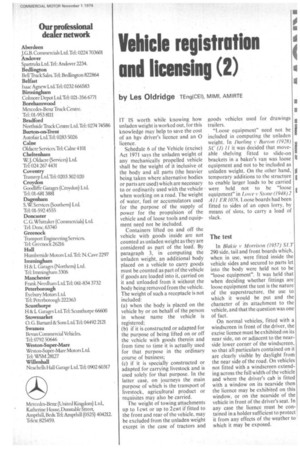Vehicle registration and licensing (2)
Page 35

If you've noticed an error in this article please click here to report it so we can fix it.
by Les Oldridge TEng(CEI), MIMI, AMIRTE IT IS worth while knowing how unladen weight is worked out, for this knowledge may help to save the cost of an hgv driver's licence and an 0 licence.
Schedule 6 of the Vehicle (excise) Act 1971 says the unladen weight of any mechanically propelled vehicle shall be the weight of it inclusive of the body and all parts (the heavier being taken where alternative bodies or parts are used) which are necessary to or ordinarily used with the vehicle when working on a road. The weight of water, fuel or accumulators used for the purpose of the supply of power for the propulsion of the vehicle and of loose tools and equipment need not be included.
Containers lifted on and off the vehicle with goods inside are not counted as unladen weight as they are considered as part of the load. By paragraph 3, in computing the unladen weight, an additional body placed on a vehicle to carry goods must he counted as part of the vehicle if goods are loaded into it, carried on it and unloaded from it without the body being removed from the vehicle. The weight of such a receptacle is not included: (a) when the body is placed on the vehicle by or on behalf of the person in whose name the vehicle is registered; (b) if it is constructed or adapted for the purpose of being lifted on or off the vehicle with goods therein and from time to time it is actually used for that purpose in the ordinary course of business; (c) if it is specially constructed or adapted for carrying livestock and is used solely for that purpose. In the latter case, on journeys the main purpose of which is the transport of livestock, agricultural product or requisites may also be carried.
The weight of towing attachments up to I cwt or up to 2cwt if fitted to the front and rear of the vehicle, may be excluded from the unladen weight except in the case of tractors and goods vehicles used for drawings trailers.
"Loose equipment" need not be included in computing the unladen weight. In Darlinf; N. Burton (1928) SC' (J) I I it was decided that moveable shelving fitted to slide-on brackets in a baker's van was loose equipment and not to be included as unladen weight. On the other hand, temporary additions to the structure to enable larger loads to be carried were held not to be "loose equipment" in Lowe v Stone (1948)2 A11 ER 1076. Loose boards had been fitted to sides of an open lorry, by means of slots, to carry a load of slack.
The test In Blakie 1. Morrison (1957) SLT 290 side, tail and front boards which, when in use, were fitted inside the vehicle sides and secured to parts let into the body were held not to be "loose equipment". It was held that when deciding whether fittings are loose equipment the test is the nature of the superstructure, the use to which it would be put and the character of its attachment to the vehicle, and that the question was one of fact.
On normal vehicles, fitted with a windscreen in front of the driver, the excise licence must be exhibited on its near side, on or adjacent to the nearside lower corner of the windscreen, so that all particulars contained on it are clearly visible by daylight from the near side of the road. On vehicles not fitted with a windscreen extending across the full width of the vehicle and where the driver's cab is fitted with a window on its nearside then the licence may be exhibited on this window, or on the nearside of the vehicle in front of the driver's seat. In any case the licence must be contained in a holder sufficient to protect it from any effects of the weather to which it may be exposed.






























































































